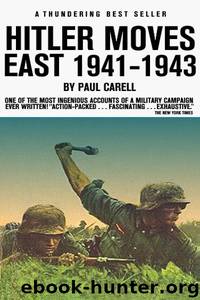Hitler Moves East, 1941-1943 by Paul Carell

Author:Paul Carell [Carell, Paul]
Language: eng
Format: epub
Tags: Non-Fiction, War/Military, WWII, Russia, Eastern Front, Wehrmacht
Published: 1966-03-14T16:00:00+00:00
At the beginning of December 1941 the Soviet High Command had concentrated altogether 17 /i Armies for an attack against the German Army Group Centre. Three of these— the First, Tenth, and Twentieth Armies—consisted of Siberian and Asian divisions which had been newly raised. The other Armies, according to the reliable military historian Samsonov, had been "trebled or quadrupled by the inclusion of reserves." Russian military writers, who are fond of playing down their own numbers while invariably overestimating the German forces, quote the ratio between German and Soviet strength at the beginning of the counter-offensive as 1.5 to 1 in favour of the Soviets. And this Soviet superiority became more marked with each week that passed.
Throughout December the German Army Group Centre received not a single fresh division. The Russian "Western Front," on the other hand, which was facing it, was reinforced during that same period by thirty-three divisions and thirty-nine brigades. These figures speak for themselves. Germany's resources were inadequate. She was waging a war beyond her capabilities.
What were the Soviet High Command's plans for its counter-offensive? Even without official Soviet sources the answer would be easy. It sprang from the situation itself. The first task was to smash the two powerful German armoured wedges threatening Moscow from the north and south.
Whether—as is nowadays claimed by Soviet military writers —the Red High Command had been planning from the very start to follow up this first objective by that of encircling the entire German Army Group Centre must remain a matter for speculation. It does not seem very plausible. But if this was indeed the plan from the outset, then it was badly conceived.
We shall presently see why.
The Soviet counter-offensive started north of Moscow with a battle for the Klin bulge. This projecting arc of the front of 3rd Panzer Group was the most serious threat to the Red capital.
At the very heart of this battle were the German XLI and LVI Panzer Corps with 36th and 14th Motorized Infantry Divisions, 6th and 7th Panzer Divisions, as well as—since 7th December—1st Panzer Division. General Schaal, formerly the commander of the well-tried 10th Panzer Division, was now in command of LVI Panzer Corps. There exists a report of his which, together with the operation reports of the separate divisions, provides an impressive and historically interesting picture of the dramatic happenings. They show, by the example of the Klin bulge, how the fate of the northern wing of Army Group Centre early in December 1941 frequently hung by a thread. They also show under what difficult conditions, with what inadequate forces, and with what heroic efforts the troops and their officers were meeting the danger.
In the grey dawn of 5th December, as the initial Russian artillery bombardment made the relieved pickets of 87th Infantry Regiment run for cover by the Yakhroma, Soviet regiments were already charging the forward lines of 36th and, next to it, 14th Motorized Infantry Divisions between Rogachevo and the southern edge of the Volga reservoir. A Soviet
Download
This site does not store any files on its server. We only index and link to content provided by other sites. Please contact the content providers to delete copyright contents if any and email us, we'll remove relevant links or contents immediately.
| Africa | Americas |
| Arctic & Antarctica | Asia |
| Australia & Oceania | Europe |
| Middle East | Russia |
| United States | World |
| Ancient Civilizations | Military |
| Historical Study & Educational Resources |
Room 212 by Kate Stewart(4988)
The Crown by Robert Lacey(4703)
Endurance: Shackleton's Incredible Voyage by Alfred Lansing(4648)
The Iron Duke by The Iron Duke(4265)
The Rape of Nanking by Iris Chang(4117)
Joan of Arc by Mary Gordon(3997)
Killing England by Bill O'Reilly(3936)
Say Nothing by Patrick Radden Keefe(3863)
I'll Give You the Sun by Jandy Nelson(3338)
Shadow of Night by Deborah Harkness(3272)
Hitler's Monsters by Eric Kurlander(3252)
Mary, Queen of Scots, and the Murder of Lord Darnley by Alison Weir(3128)
Blood and Sand by Alex Von Tunzelmann(3112)
Darkest Hour by Anthony McCarten(3052)
Eleanor & Park by Rainbow Rowell(3024)
Margaret Thatcher: The Autobiography by Thatcher Margaret(3016)
Red Famine: Stalin's War on Ukraine by Anne Applebaum(2854)
Book of Life by Deborah Harkness(2847)
The One Memory of Flora Banks by Emily Barr(2767)
